
Jorge Mario Pedro Vargas Llosa, 1st Marquess of Vargas Llosa, more commonly known as Mario Vargas Llosa, is a Peruvian novelist, journalist, essayist and former politician. Vargas Llosa is one of Latin America's most significant novelists and essayists and one of the leading writers of his generation. Some critics consider him to have had a larger international impact and worldwide audience than any other writer of the Latin American Boom. In 2010, he won the Nobel Prize in Literature, "for his cartography of structures of power and his trenchant images of the individual's resistance, revolt, and defeat." He also won the 1967 Rómulo Gallegos Prize, the 1986 Prince of Asturias Award, the 1994 Miguel de Cervantes Prize, the 1995 Jerusalem Prize, the 2012 Carlos Fuentes International Prize, and the 2018 Pablo Neruda Order of Artistic and Cultural Merit. In 2021, he was elected to the Académie française.
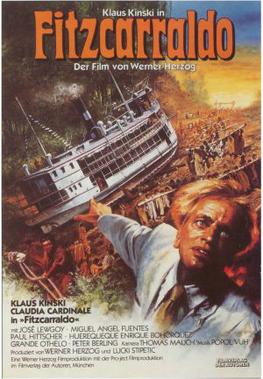
Fitzcarraldo is a 1982 West German epic adventure-drama film written, produced, and directed by Werner Herzog, and starring Klaus Kinski as would-be rubber baron Brian Sweeney Fitzgerald, an Irishman known in Peru as Fitzcarraldo, who is determined to transport a steamship over a steep hill to access a rich rubber territory in the Amazon basin. The character was inspired by Peruvian rubber baron Carlos Fitzcarrald, who once transported a disassembled steamboat over the Isthmus of Fitzcarrald.
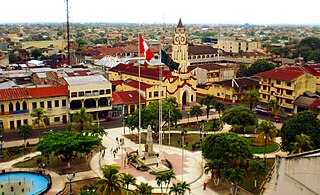
Iquitos is the capital city of Peru's Maynas Province and Loreto Region. It is the largest metropolis in the Peruvian Amazon, east of the Andes, as well as the ninth-most populous city in Peru. Iquitos is the largest city in the world that cannot be reached by road that is not on an island; it is only accessible by river and air.

Aunt Julia and the Scriptwriter is the seventh novel by Nobel Prize-winning author Mario Vargas Llosa. It was published by Seix Barral, S.A., Spain, in 1977.

Charles Wiener (1851–1913) was an Austrian-French scientist-explorer. Born in Vienna, he is perhaps best known as the explorer who traveled extensively in Peru, climbed the Illimani and came close to re-discovering Machu Picchu.

La Casa de Fierro, located in the city of Iquitos in the jungle of Peru, in front of the major square between Próspero and Putumayo streets, is a large iron residence built during the rubber boom at the end of the nineteenth century. The house was bought by the Bolivian explorer and entrepreneur Antonio Vaca Diez.
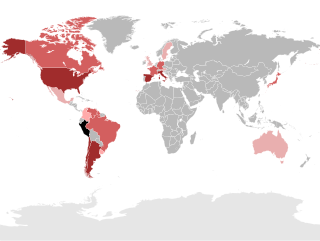
Peruvians are the citizens of Peru. What is now Peru has been inhabited for several millennia by cultures such as the Caral before the Spanish conquest in the 16th century. Peruvian population decreased from an estimated 5–9 million in the 1520s to around 600,000 in 1620 mainly because of infectious diseases carried by the Spanish. Spaniards and Africans arrived in large numbers in 1532 under colonial rule, mixing widely with each other and with Native Peruvians. During the Republic, there has been a gradual immigration of European people. Chinese and Japanese arrived in large numbers at the end of the 19th century.

The Latin American Boom was a literary movement of the 1960s and 1970s when the work of a group of relatively young Latin American novelists became widely circulated in Europe and throughout the world. The Boom is most closely associated with Julio Cortázar of Argentina, Carlos Fuentes of Mexico, Mario Vargas Llosa of Peru, and Gabriel García Márquez of Colombia. Influenced by European and North American Modernism, but also by the Latin American Vanguardia movement, these writers challenged the established conventions of Latin American literature. Their work is experimental and, owing to the political climate of the Latin America of the 1960s, also very political. "It is no exaggeration", critic Gerald Martin writes, "to state that if the Southern continent was known for two things above all others in the 1960s, these were, first and foremost, the Cuban Revolution and its impact both on Latin America and the Third World generally, and secondly, the Boom in Latin American fiction, whose rise and fall coincided with the rise and fall of liberal perceptions of Cuba between 1959 and 1971."

The Way to Paradise is a novel published by Mario Vargas Llosa in 2003.

The War of the End of the World is a 1981 novel written by Peruvian novelist Mario Vargas Llosa, who won the 2010 Nobel Prize in Literature. It is a fictionalized account of the War of Canudos conflict in late 19th-century Brazil.
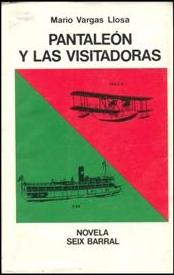
Captain Pantoja and the Special Service is a relatively short comedic novel by acclaimed Peruvian writer Mario Vargas Llosa.
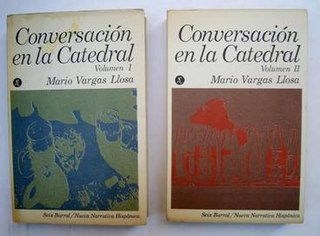
Conversation in The Cathedral is a 1969 novel by Spanish-Peruvian writer and essayist Mario Vargas Llosa, translated by Gregory Rabassa. One of Vargas Llosa's major works, it is a portrayal of Peru under the dictatorship of Manuel A. Odría in the 1950s, and deals with the lives of characters from different social strata. The ambitious narrative is built around the stories of Santiago Zavala and Ambrosio respectively; one the son of a minister, the other the minister's chauffeur. A random meeting at a dog pound leads to a riveting conversation between the two at a nearby bar known as The Cathedral. During the encounter Zavala tries to find the truth about his father's role in the murder of a notorious Peruvian underworld figure, shedding light on the workings of a dictatorship along the way.

The Storyteller is a novel by Peruvian author and Literature Nobel Prize winner Mario Vargas Llosa. The story tells of Saúl Zuratas, a university student who leaves civilization and becomes a "storyteller" for the Machiguenga Native Americans. The novel thematizes the Westernization of indigenous peoples through missions and through anthropological studies, and questions the perceived notion that indigenous cultures are set in stone.
Larreategui is a Basque surname that may refer to people called Larreátegui or Reátegui.
The cinema of Iquitos, also known as Amazonian cinema, is an important film development and one of the historic pioneering event of cinema of Peru. Due to the rubber boom and the arrival of foreigners, film interest began in the early 20th century, along with the evolution of cinema of the United States in Hollywood. Cinema in Iquitos had no established date of origin. The first film, however, was made in 1900. The first films were shown in the Casa de Fierro with an Edison machine, which reproduced the images using a carbide lamp and the constant movement of the operator. Iquitos is mentioned as a metonym of cinema in the Peruvian Amazon.

Every Blood is the fifth novel of the Peruvian writer José María Arguedas published in 1964. It is the author's longest and most ambitious novel, being an attempt to portray the whole of Peruvian life, by means of representations of geographic and social scenes of the entire country, although its focus is on the Andean sierra. The title alludes to the racial, regional and cultural diversity of the Peruvian nation. The novel revolves around two fundamental ideas: the danger of imperialist penetration into the country through large transnational companies, and the problem of modernization of the indigenous world.

Deep Rivers is the third novel by Peruvian writer José María Arguedas. It was published by Losada in Buenos Aires in 1958, received the Peruvian National Culture Award in 1959, and was a finalist in the William Faulkner Foundation Ibo-American award (1963). Since then, critical interest in the work of Arguedas has grown, and the book has been translated into several languages.

The Fox From Up Above and the Fox From Down Below is the sixth and final novel by Peruvian writer José María Arguedas published posthumously in 1971. It is an unfinished novel, interspersed with some personal and intimate diaries where the author relates the torments overwhelming him while writing the novel, finally announcing his impending suicide. Complementing the work are two letters and an epilogue. The novel depicts the consequences of accelerated modernization of the port of Chimbote, motivated by the fishing boom; thousands of Andean immigrants arrive, attracted by the opportunity to earn a living in a thriving industrial city, while at the same time they assimilate themselves under the guise of 'modernity', all of which, from the point of the writer, brings dire consequences: loss of Andean cultural identity and its moral degeneracy, succumbing to the vices of the city in bars and brothels.

The 2010 Nobel Prize in Literature was awarded the Peruvian writer Mario Vargas Llosa "for his cartography of structures of power and his trenchant images of the individual's resistance, revolt, and defeat." The prize was announced by the Swedish Academy on 7 October 2010. He is the first Nobel laureate in Literature from Peru and the fifth Latin American to become one after 1982 Colombian laureate Gabriel García Márquez and 1971 Chilean laureate Pablo Neruda.

Luis Alberto Flores Medina was a Peruvian lawyer, politician and diplomat. He was the Supreme Chief of the Revolutionary Union, a fascist party modelled after its italian counterpart, after the assassination of the party's founder, Luis Miguel Sánchez Cerro. He also served as a deputy for Lima and as Senator for Piura and Minister of Navy and Aviation, Government and Police and President of the Council of Ministers of Peru.

















